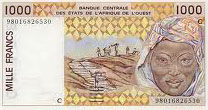|


The West African CFA franc (French: franc CFA or simply franc, ISO 4217 code: XOF) is the currency of eight independent states spanning over 1,350,000 square miles (3,500,000 km2) in West Africa: Benin, Burkina Faso, Côte d'Ivoire, Guinea-Bissau, Mali, Niger, Sénégal and Togo. The acronym CFA stands for Communauté financière d'Afrique ("Financial Community of Africa"). The currency is issued by the BCEAO (Banque Centrale des États de l'Afrique de l'Ouest, "Central Bank of the West African States"), located in Dakar, Senegal, for the members of the UEMOA (Union Économique et Monétaire Ouest Africaine, "West African Economic and Monetary Union"). The franc is nominally subdivided into 100 centimes but no centime denominations have been issued.
In several central African states, the Central African CFA franc, which is of equal value to the West African CFA franc, is in circulation. They are both the CFA franc.
History
The CFA franc was introduced to the French colonies in west Africa in 1945, replacing the French West African franc. The west African colonies and territories using the CFA franc were Côte d'Ivoire, Dahomey, French Sudan, Mauritania, Niger, Sénégal, Togo and Upper Volta. The currency continued in use when these colonies gained their independence, except in Mali (formerly French Sudan), which replaced at par the CFA franc with its own franc in 1961. In 1973, Mauritania replaced the CFA franc with the ouguiya at a rate of 1 ouguiya = 5 francs. Mali readopted the CFA franc in 1984, at a rate of 1 CFA franc = 2 Malian francs. The former Portuguese colony of Guinea-Bissau adopted the CFA franc in 1994, replacing the Guinea Bissau peso at a rate of 1 CFA franc = 65 pesos.
Coins
In 1948, aluminium 1- and 2-franc coins were introduced. These were followed in 1956 by aluminium-bronze 5, 10 and 25 francs. All carried the name Afrique Occidentale Française. In 1957, 10- and 25-franc coins were issued with the name of Togo added. From 1959, coins have been issued by the BCEAO. Nickel 100-franc coins were introduced in 1967, followed by the cupro-nickel 50-franc coins in 1972. Small, steel 1-franc coins were introduced in 1976 (struck until 1995), followed by bimetallic 250 francs in 1992 (struck until 1996). In 2003, bimetallic 200- and 500-franc coins were introduced.
Banknotes
When the CFA franc was introduced, notes issued by the Banque Centrale des États de l'Afrique Occidentale in denominations of 5, 10, 25, 50, 100 and 1000 francs were in circulation. 500-franc notes were added in 1946, followed by those of 5,000 francs in 1948. In 1955, the Institut d'Emission de l'A.O.F. et du Togo took over the production of paper money, issuing notes for 50, 100, 500 and 1000 francs.
In 1959, the BCEAO took over the issuance of paper money and reintroduced a 5,000-franc note. With the exception of a few early issues, the notes of the BCEAO carry a letter to indicate the country of issuance. 50-franc notes were last issued in 1959, with 100 francs not issued since 1965. 10,000-franc notes were introduced in 1977, followed by 2,500-franc notes in 1992
In 2004, a new series of notes was introduced in denominations of 1,000, 2,000, 5,000 and 10,000 francs, with the 500-franc note having been replaced by a coin the year before. The newer notes contain updated security features and are more modern in design. The change was welcomed because of a perception that the old notes were dirty and disease-ridden. The colour of the 5,000-franc note was changed from blue to green.
Future proposals
The English-speaking states of Gambia, Ghana, Nigeria, and Sierra Leone, along with the French-speaking state of Guinea, have formed the West African Monetary Zone (WAMZ) and aims to introduce a common currency, the Eco, on 1 January 2015. Liberia is also set to join this monetary zone, whose ultimate goal is to unite the UEMOA and the WAMZ to form a single West African monetary zone.
The text on this page has been made available under the Creative Commons Attribution-ShareAlike License and Creative Commons Licenses
|
